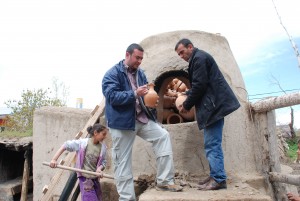By: Dr. Atilla Batmaz
To learn how the production chain of the Urartian pottery was, Dr. Atilla Batmaz and his team carry on studies on an experimental scale in the Bardakçı Village of Van (Eastern Turkey).
In, they began experiments about how the Urartian red polished pottery might have been made together with a potter, Osman Eşme, in the Bardakçı Village of Van, which is famous for pottery making. As the knowledge of the technology and production of this type of pottery was limited, they decided to make such an experimental archaeology study. They suppose that the local clay beds from which they obtained clay were likely to have been used in the Urartian period as well. After they have made the clay ready for being treated, they will try to shape it into the most common shapes of Urartu, such as trefoil jug, goblet, bowl, and plate, as in the ancient period. They will continue the studies on an experimental scale in the Bardakçı Village of Van regarding how the production chain of the Urartian pottery was. This year they concentrate on surface treatments such as slip and polish and on its firing. For the time being, we are performing firing in a mud and domed kiln which is similar to that used in the ancient period.
Dr. Batmaz’s team consists of members of Osman Eşme’s core family Zeynep Eşme (12), Oğuzhan Eşme (10), Rabia Eşme (8), Nurullah Eşme (5), Yakup Eşme (4), Burak Eşme (2) and their mother Fatma Eşme. They have served a constant support in every stage this project.
Having expressed that these studies might be an important stage in terms of fully clarifying the production chain of the Urartian red polished pottery, Dr. Batmaz stated, “We aim to carry out such details as the production techniques, methods, surface treatments, and firing of the type of pottery concerned in practice.”
 Dr. Batmaz said that the studies were going on without obtaining support from any institutions or organizations and added, “Their integration with the society will be possible only if they can be supported. Our objective is to teach this pottery to the public after we have produced it under ancient and modern conditions. As in Avanos, conveying the pottery making of the Urartian culture, which existed some 2,700 years ago, to both the local people and the tourists who visit the region and even teaching them how to do it will be a crucial step for the Urartian culture and the region.”
Dr. Batmaz said that the studies were going on without obtaining support from any institutions or organizations and added, “Their integration with the society will be possible only if they can be supported. Our objective is to teach this pottery to the public after we have produced it under ancient and modern conditions. As in Avanos, conveying the pottery making of the Urartian culture, which existed some 2,700 years ago, to both the local people and the tourists who visit the region and even teaching them how to do it will be a crucial step for the Urartian culture and the region.”
Dr. Atilla Batmaz, a Research Assistant at the Department of Archaeology in the Faculty of Letters at Ege University, conducts studies on the reproduction of the Urartian Red Polished Pottery.
~~~
All content provided on this blog is for informational purposes only. The American Schools of Oriental Research (ASOR) makes no representations as to the accuracy or completeness of any information on this blog or found by following any link on this blog. ASOR will not be liable for any errors or omissions in this information. ASOR will not be liable for any losses, injuries, or damages from the display or use of this information. The opinions expressed by Bloggers and those providing comments are theirs alone, and do not reflect the opinions of ASOR or any employee thereof.

